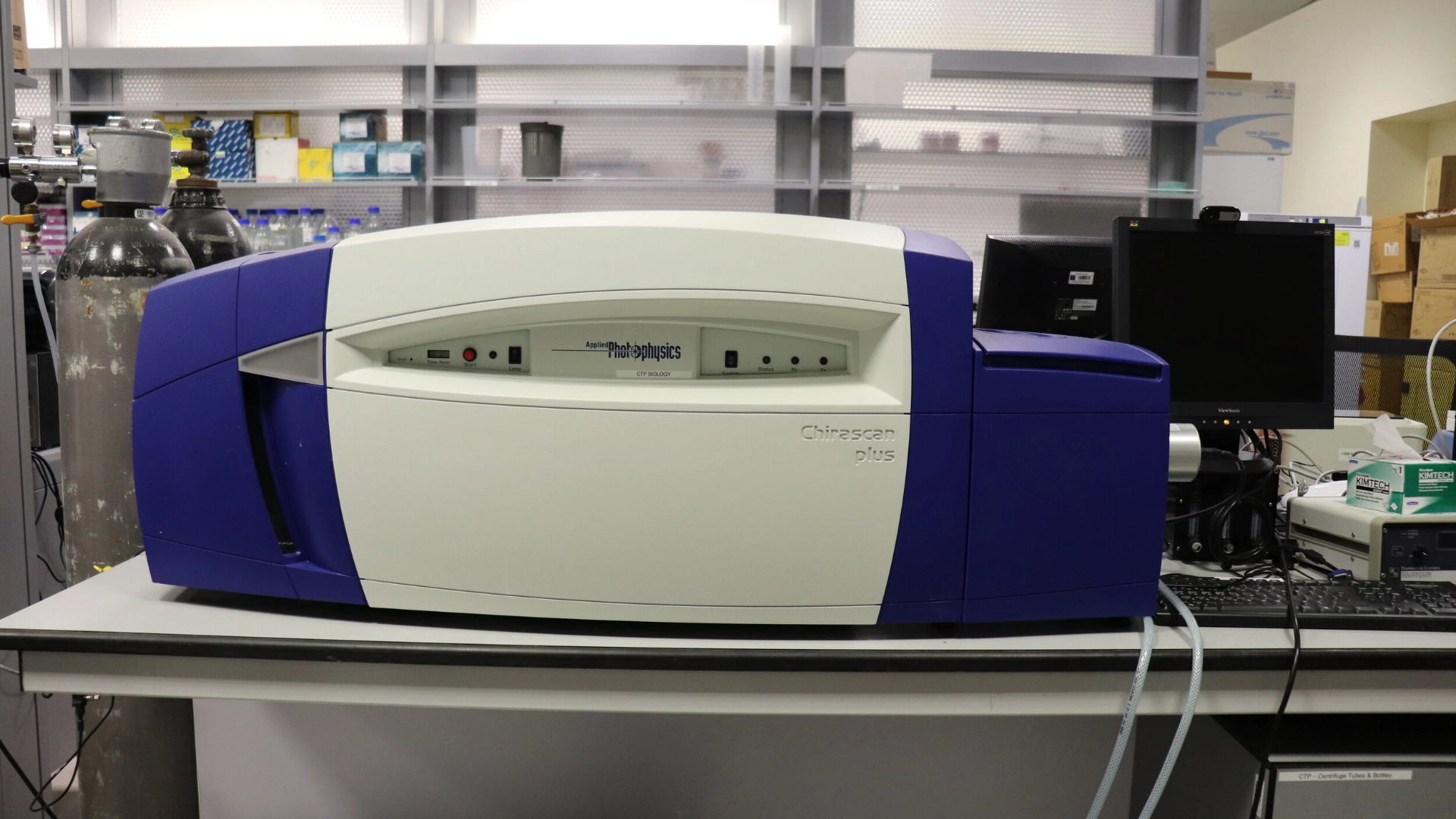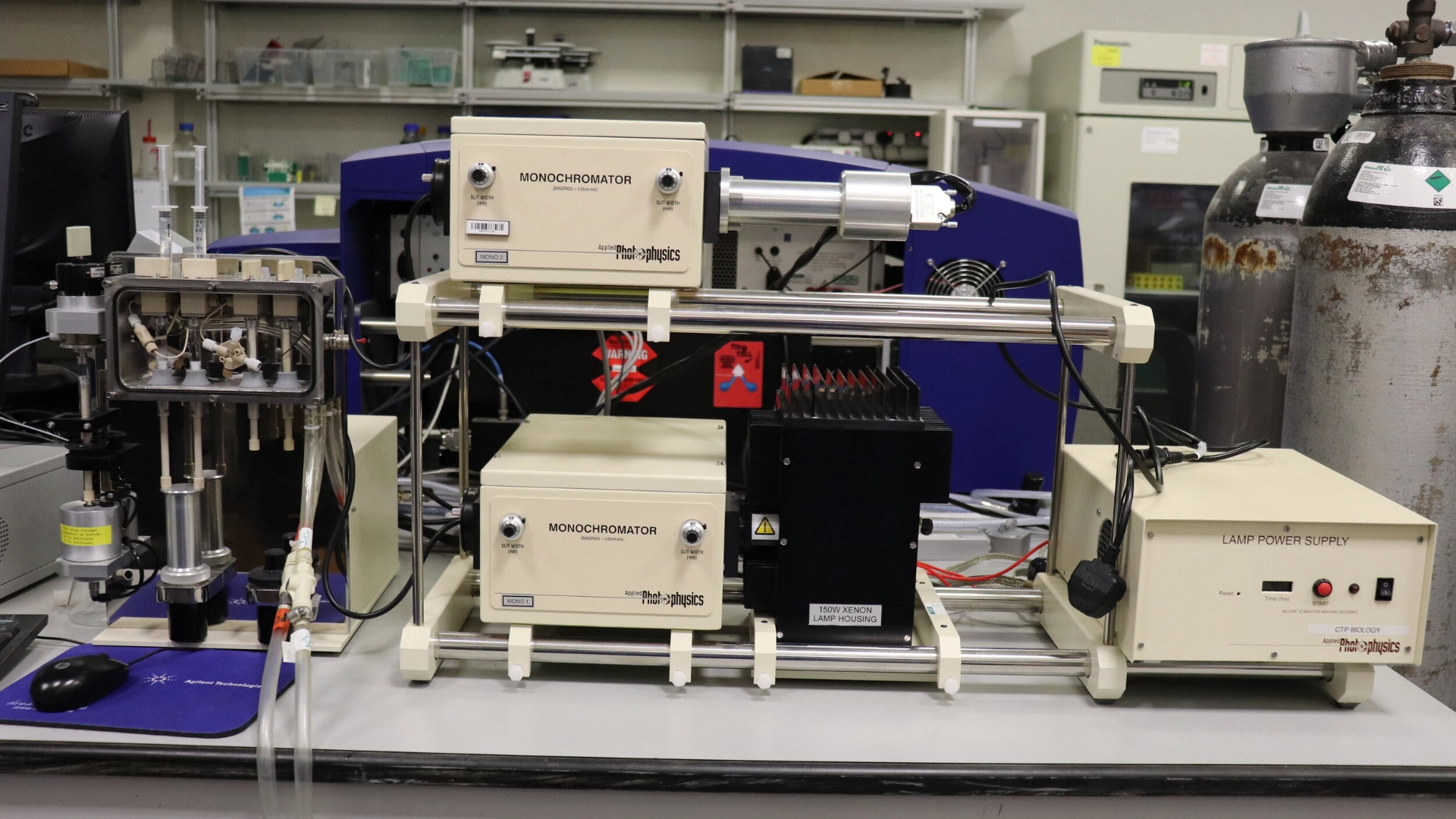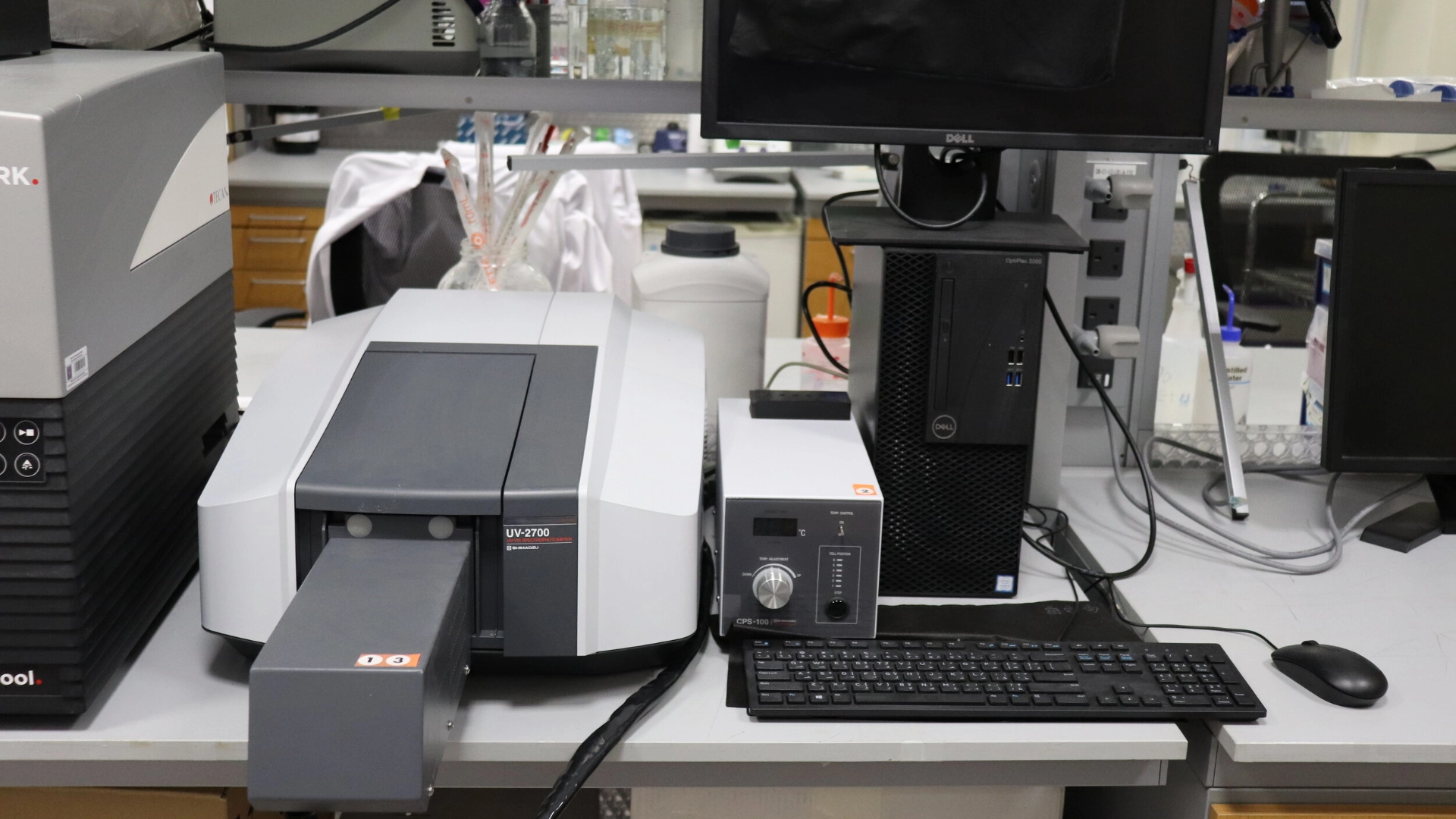Spectroscopy
Techniques and Applications of Spectrometry in Biophysical Chemistry
Circular Dichroism (CD) Spectrometer

The Chirascan-plus is a scientific instrument designed for circular dichroism (CD) and fluroescence spectroscopy. It is commonly used in research fields such as biophysics, structural biology, and materials science to study the structural properties of molecules, particularly proteins, nucleic acids, and other chiral (optically active) compounds.
Key Features
Circular Dichroism (CD) Spectroscopy:
- Measures the difference in absorption of left- and right-circularly polarized light by a sample, providing information about the secondary structure of proteins, nucleic acids, and other chiral molecules.
- Provides data on the secondary and tertiary structure of biomolecules, including α-helices, β-sheets, and disordered regions in proteins.
Fluorescence Spectroscopy:
- Allows the study of fluorescence emission spectra, which can be correlated with the conformation and environment of fluorescently labeled molecules.
- Useful in applications such as protein folding, conformational changes, and monitoring molecular interactions.
Simultaneous CD and Fluorescence Measurements:
- One of the key innovations of the Chirascan-plus is the ability to perform simultaneous CD and fluorescence measurements, providing complementary data on a molecule’s structure and behavior in solution.
- This simultaneous measurement helps in understanding conformational changes in real time, especially when the molecular structure is sensitive to changes in conditions (e.g., pH, temperature, solvent environment).
High Sensitivity and Resolution:
- The Chirascan-plus offers high sensitivity and resolution in CD and fluorescence measurements, which is essential for detecting small changes in molecular structure, especially for dilute or low-abundance samples.
Broad Wavelength Range:
- The instrument typically covers a wide spectral range, often from 190 nm to 800 nm for CD measurements, and the fluorescence spectra can cover from ultraviolet (UV) to visible wavelengths, allowing for extensive structural and dynamic studies.
Advanced Data Analysis and Software:
- The system comes with advanced software for analyzing and interpreting CD and fluorescence data, which can be used to obtain detailed information about protein folding, ligand binding, and structural transitions.
User-Friendly Interface:
- The Chirascan-plus is designed to be user-friendly, with intuitive controls and easy-to-understand software interfaces, which makes it accessible for both experienced researchers and those new to CD or fluorescence spectroscopy.
Applications
Protein Structure and Folding:
- Secondary structure analysis: The Chirascan-plus is widely used to study the secondary structure of proteins, determining the relative amounts of α-helices, β-sheets, and random coils.
- Protein folding studies: Researchers use it to monitor conformational changes in proteins as they fold or unfold under different conditions (e.g., temperature, pH, or the presence of ligands).
- Denaturation and refolding: CD spectroscopy allows for monitoring the effects of denaturing agents (such as urea or guanidine) and studying protein refolding after denaturation.
Nucleic Acid Structure:
- It can also be used to study the secondary structure of DNA, RNA, and their interactions with ligands or other molecules.
- DNA-RNA interactions, and the effects of binding ligands or small molecules on nucleic acid structure, can be studied using CD combined with fluorescence.
Enzyme-Ligand Interactions:
- The system is often used to monitor the structural changes that occur in enzymes or other biomolecules upon binding to ligands or small molecules. This helps in understanding mechanisms of enzyme catalysis, protein-ligand interactions, and other biochemical processes.
Protein-Protein and Protein-DNA Interactions:
- Chirascan-plus is valuable for studying protein-protein and protein-DNA interactions, providing insight into how binding events affect protein conformations.
Thermal Unfolding Studies:
- The device can be used to investigate thermal denaturation, where the temperature is gradually increased, and structural changes are monitored. This is particularly useful for understanding the stability of proteins or nucleic acids in different environments.
Characterizing Aggregation and Misfolding:
- The system helps in studying protein aggregation, misfolding, and amyloid formation, which are key areas of research in neurodegenerative diseases like Alzheimer’s and Parkinson’s.
Structural Studies of Small Molecules:
- Besides proteins and nucleic acids, Chirascan-plus can be used for studying chiral small molecules, which are important in areas like drug discovery and materials science.
Monitoring of Conformational Transitions:
- The simultaneous measurement of CD and fluorescence allows for real-time monitoring of molecular conformational transitions in response to environmental changes, such as pH, ionic strength, or solvent conditions.
Microplate Readers
The Spark and Synergy H1 are both multi-mode microplate readers, commonly used in life science and laboratory settings for a variety of biological, chemical, and biochemical assays.
The Spark is a versatile multi-mode microplate reader designed to provide a wide range of optical measurements. It’s used for applications in molecular biology, drug discovery, cell biology, and other laboratory fields.
The Synergy H1 is another high-performance multi-mode microplate reader. Like the Spark, it is designed for a broad range of assays, providing flexibility in applications that require a wide range of optical measurements.
Key Features
Spark
- Multi-mode Detection: The Spark can perform absorbance, fluorescence, luminescence, time-resolved fluorescence (TRF), and other assays, allowing flexibility in experimental design.
- Wavelength Range: It covers a broad wavelength range (typically 200–1000 nm), making it suitable for a variety of assays that involve different light absorption and emission properties.
- High Sensitivity: The Spark provides high sensitivity measurements, especially useful for low-concentration samples.
- Modular Design: The system offers modular components (e.g., temperature control, shaking, and automated dispensing), making it customizable for specific experimental needs.
- Touchscreen Interface: It includes a user-friendly touchscreen interface and software (i.e., SparkControl) that makes operation intuitive and easy.
- Integrated Optical System: It features advanced optical systems that reduce noise and improve accuracy.
- Environmental Control: Some versions come with a built-in incubator or heating/cooling capabilities, which is important for assays requiring precise temperature control.
- Automation: Compatible with Tecan’s liquid handling systems for high-throughput screening (HTS).
Synergy H1
- Multi-Mode Detection: The Synergy H1 can perform multiple detection modes, including absorbance, fluorescence, luminescence, and time-resolved fluorescence (TRF).
- Wavelength Range: Offers a broad wavelength range (typically 200–1000 nm) for flexibility in detecting different molecules.
- Advanced Fluorescence Detection: Includes a high-quality fluorescence optics system, with fluorescence intensity and fluorescence polarization capabilities.
- Upgradable Optics: The system can be upgraded with different optical modules to suit specific applications (e.g., for additional fluorescence or chemiluminescence features).
- Fast Measurement: Capable of fast reading speeds, making it suitable for high-throughput and time-sensitive assays.
- Temperature Control: Many models include temperature control features (e.g., temperature range from ambient to 45°C) for assays requiring thermal management.
- User-Friendly Software: BioTek’s Gen5™ Software allows for seamless data acquisition, analysis, and reporting.
- Compact Design: The Synergy H1 is relatively compact, making it ideal for smaller labs with limited space.
- Automation Ready: Can be integrated with automated liquid handling systems for high-throughput screening applications.
Applications
Spark
- Enzyme-Linked Immunosorbent Assays (ELISA): Quantitative detection of analytes in biological samples.
- Cell-based Assays: Monitoring cell viability, proliferation, and toxicity (e.g., MTT, resazurin assays).
- Fluorescence and Luminescence: Used in assays like qPCR, protein-protein interaction studies, and gene expression monitoring.
- Kinetics and Time-Resolved Fluorescence: Tracking dynamic biochemical reactions or measuring transient signals.
- High-throughput Screening (HTS): Analyzing a large number of compounds in drug discovery research.
Synergy H1
- Drug Discovery: Screening for potential drug candidates, including high-throughput screening of compound libraries.
- Cell-based Assays: Assessing cell viability, cytotoxicity, and other cellular responses using techniques like MTT, ATP, or cell proliferation assays.
- ELISA: Detection of target analytes in a variety of sample types, including blood, serum, and cell culture supernatants.
- Gene Expression and PCR: Detection of gene expression and monitoring PCR assays in real-time.
- Protein-Protein Interactions: Studying protein interactions and interactions with other biomolecules using fluorescence polarization or resonance energy transfer assays.
- Enzyme Assays: Monitoring enzyme activity or enzyme kinetics, especially for biochemical research.
Stopped-Flow Spectrometer

The Spark SX20 stopped-flow spectrometer is a scientific instrument used primarily for time-resolved spectroscopy in biochemical and biophysical applications. It is designed to study fast kinetic processes that occur on timescales ranging from milliseconds to seconds, making it a key tool for investigating rapid molecular interactions and conformational changes.
Key Features
Stopped-Flow Technology:
- The Spark SX20 is based on the stopped-flow technique, which rapidly mixes two or more solutions and then measures the resulting changes in absorbance or fluorescence over time.
- The flow of liquid through the system is “stopped” after the mixing point to enable fast measurements, capturing the kinetics of the reaction or process.
Time-Resolved Spectroscopy:
- The instrument allows for time-resolved measurements in the UV-Visible and fluorescence regions, providing detailed insights into the kinetics of fast processes.
- It can measure reaction rates, concentration changes, and other dynamic properties with high precision.
Wide Time Range:
- The Spark SX20 is capable of monitoring ultra-fast reactions on timescales as short as milliseconds, offering the ability to capture rapid molecular events, such as enzyme kinetics, protein folding, and ligand binding.
Dual-Detection System:
- The device typically integrates both absorbance and fluorescence detection, which is useful for studying a broad range of biomolecular interactions.
- This dual detection enables the study of different types of sample behavior, from simple concentration changes to complex molecular conformations.
Software Integration:
- It comes with advanced software for data analysis, including kinetics modeling, fitting, and graphing, which simplifies the interpretation of complex data sets.
- The software also allows for real-time monitoring and recording of kinetic data during experiments.
High Sensitivity:
- The system is designed for high sensitivity and excellent signal-to-noise ratios, enabling the detection of small changes in absorbance or fluorescence that occur during fast molecular events.
Flexible Sample Handling:
- The system supports a variety of sample types, including proteins, nucleic acids, small molecules, and more, making it versatile across different disciplines.
Applications
Enzyme Kinetics:
- The Spark SX20 is widely used for studying the kinetics of enzyme catalyzed reactions, enabling the investigation of reaction rates, substrate affinity, and the effects of inhibitors or activators.
Protein Folding and Stability:
- Researchers use the spectrometer to study protein folding dynamics, conformational changes, and the effects of environmental conditions (e.g., temperature, pH) on protein stability.
Ligand Binding Studies:
- The instrument is employed in studies of ligand-receptor interactions, allowing the measurement of binding rates and affinities, which are crucial in drug development and understanding biological processes.
Cellular Signaling:
- It can be applied to monitor signaling pathways by tracking the activation and deactivation of key proteins, often using fluorescence or absorbance probes in live cells.
Nucleic Acid Hybridization:
- The Spark SX20 can be used for investigating DNA/RNA hybridization kinetics, as well as the interactions between nucleic acids and small molecules or proteins.
Fast Reaction Monitoring in Biochemistry:
- The device is ideal for studying chemical reaction dynamics in biochemistry, where reactions occur on very short timescales (e.g., molecular interactions, redox reactions).
Pharmacological Research:
- The Spark SX20 is often used in the field of pharmacology to explore the effects of drugs on various biomolecules, including their binding kinetics, stability, and potential therapeutic effects.
UV-Vis Absorption Spectrometer

The UV-2700 is a UV-Vis (Ultraviolet-Visible) designed for measuring the absorbance of light in the ultraviolet (UV) and visible (Vis) regions of the electromagnetic spectrum. This type of spectrophotometer is commonly used in a variety of applications to analyze the light absorption characteristics of samples, which can help determine the concentration of analytes, molecular structure, and other properties of substances.
Key Features
Wavelength Range:
- The UV-2700 typically operates within the 190 nm to 1100 nm wavelength range, covering both the UV and visible regions of the spectrum.
High Optical Performance:
- Equipped with high-performance optical components and a double-beam design, it ensures high accuracy and precision in measurements. The double-beam design splits the light between the reference and sample, minimizing the effects of fluctuations in the light source and improving stability.
High Sensitivity:
- It offers excellent sensitivity and low baseline noise, which is crucial for accurate detection of low-concentration samples.
Variety of Detectors:
- The spectrophotometer typically uses photodiode arrays or PMT (Photomultiplier Tubes) to detect light across the spectrum, ensuring high reliability in measurements.
Intuitive Software:
- The LabSolutions software (or similar Shimadzu software) provides an easy-to-use interface for controlling the instrument, performing data analysis, and generating reports. It supports various analysis modes, such as quantitative analysis, spectral scanning, kinetics, and more.
Pathlength Correction:
- The instrument has advanced features like automatic pathlength correction to compensate for differences in cuvette sizes, ensuring accurate results in all experiments.
Data Storage and Reporting:
- The spectrophotometer allows easy data storage and export for further analysis. It can generate standard reports or customized ones depending on the needs of the user.
Applications
Chemical and Pharmaceutical Analysis:
- Quantification of compounds: The UV-2700 is often used for quantifying substances based on Beer-Lambert law, including determining the concentration of active pharmaceutical ingredients (APIs) and other chemicals in solutions.
- Purity testing: The spectrophotometer helps in evaluating the purity of compounds, especially in pharmaceutical manufacturing.
Environmental Testing:
- Water quality testing: UV-Vis spectrophotometers like the UV-2700 are employed in environmental monitoring, such as detecting pollutants in water, like nitrates, phosphates, and other chemicals.
- Soil and waste analysis: It’s also used for analyzing organic compounds in soils or waste products.
Food and Beverage Industry:
- It is used for quality control and safety testing, such as determining the concentration of additives, preservatives, and contaminants in food products.
Biochemistry and Molecular Biology:
- Protein, DNA, and RNA quantification: The UV-2700 can measure absorbance at specific wavelengths (e.g., 260 nm for nucleic acids and 280 nm for proteins) to determine the concentration of biological molecules.
- Enzyme kinetics and reaction monitoring: Spectrophotometric measurements are used to monitor reaction rates in biochemical experiments.
Material Science and Polymer Analysis:
- UV-Vis spectroscopy is frequently used for analyzing optical properties of materials, such as polymers and coatings, by assessing their absorption spectra.
Academia and Research:
- The UV-2700 is commonly used in university labs and research institutions for a wide range of analytical purposes, including teaching, experimentation, and advanced research in chemistry, biology, and environmental science.
Forensic Science:
- It is also applied in forensic science to analyze samples from crime scenes (e.g., blood, drugs, and other evidence) by identifying specific chemical markers based on their absorption spectra.

